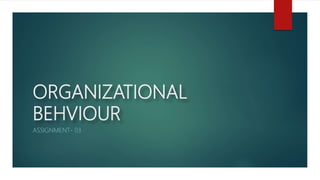
Organizational Behavior : Perception
- 2. PERCEPTION By – Anurag Priyadarshi BFT/15/1145 NIFT Patna
- 3. What is PERCEPTION? Perception is a process by which an individual organizes and interpret their sensory impressions in order to give meaning to their environment. OR The process by which individuals select, organize, and interpret the input from their senses to give meaning and order to the world around them. Perceptions vary from person to person. Different people perceive different things about the same situation. But more than that, we assign different meanings to what we perceive. And the meanings might change for a certain person.
- 4. Factors that Influences PERCEPTION PERCEPTION Factors in the Perceiver 1. Attitudes 2. Motives 3. Interests 4. Experience 5. Expectations Factors in the Target 1. Novelty 2. Motion 3. Sounds 4. Size 5. Background 6. Proximity 7. Similarity Factors in the situation 1. Time 5. Work settings 3. Social settings
- 5. The Accuracy Of Perception The accuracy of perceptions is critical, however, for a number of managerial functions. • Motivating sub-ordinates • Treating sub-ordinates fairly and equitably. • Making ethical decisions Managers who understand what perceptions are, how they are formed and what influences them are in a good position to ensure that their perceptions are as accurate as possible.
- 7. Perceptual Selection With all the stimulation impinging upon people through the environment, how and why do they select out only a very few stimuli at a given time ? Factors of Selectivity Intensity Size Contrast Repetition Motion Novelty and familiarity
- 8. Intensity- The intensity principle state that the more intense the external stimulus, the more likely it is to be perceived. A loud noise, strong odor, will be noticed more than soft sound, weak odor. Supervisors may yell at their subordinates to gain attention.
- 9. Size – This principle says that the larger the object, the more likely it will be perceived. e.g.:- Professor or manager , Maintenance engineering staff pay more attention to a big machine to a smaller one , even though the smaller one costs as much and is important to the operation . A 6 foot 5 inch , 250 pound supervisor may receive more attention from the sub ordinates than 5 foot 10 inch , 160 pound supervisor , In advertising , a full page spread is more attention- getting than a few lines in the classified section
- 10. Contrast – The contrast principle state that external stimuli that stand out against the background or which are what people are expecting will receive their attention. Ex: sign of danger. A worker with many years of experience hardly notices the deafening noise on the factory floor of a typical operation , if machines suddenly halt , the person would immediately notice the differences in noise level.
- 11. Repetition – Repeated external stimulus is more attention getting than a single once. Ex : a worker will generally “hear” better when directions for a dull task are given more than once .
- 12. Motion – It refers that people will pay more attention to moving objects in their field of vision than they will do stationary objects. Ex : workers will notice materials moving by them on conveyor belt , but they may fail to give proper attention to maintenance needs of the stationery machine next to them. Advertisers capitalize on this principle by creating which incorporate moving parts.
- 13. Novelty & familiarity – Novel or Familiar external situation can serve as an attention getter. New objects or events in the familiar setting familiar objects or events in a new setting will draw the attention of the perceiver. Ex : Job rotation Internal factors of selectivity
- 14. ATTRIBUTION THEORY OF PERCEPTION Persons Perception: Making Judgement about others
- 15. Internal and External Behaviours Internal Behaviours - Internally caused behaviours are those we believe to be under the personal control of the individual. External Behaviours – Externally caused behaviour is what we imagine the situation forced the individual to do.
- 16. Attribution Theory Attribution theory tries to explain the ways in which we judge people differently, depending on the meaning we perceive to a given behaviour. It suggests that we perceive an individuals behaviour and attempts to determine whether it was externally or internally caused. The determination depends on three factors – Distinctiveness Consensus Consistency
- 17. Social perception is directly concerned with how one individual perceives other individuals: how we get to know others. Participants in formal organization are constantly perceiving one another. Managers are perceiving workers, workers are perceiving managers etc… There are numerous factors enter into social perception i.e., attributions people make and the problems associated with stereotyping and the halo effect. Social Perception
- 18. Link Between Perception and Individual Decision Making Individuals in organization make decision. That is, they make choices from among two or more alternatives. Top managers, for instance determine their organization's goals, what produces or services to offer, how best to finance operations, or where to locate a new manufacturing plant. Middle and lower level managers determine production schedules, select new employees, and decide how pay raises are to be allocated. Of-course making decision is not the sole province of managers. Non-managerial employees also make decisions that affect their jobs and the organizations for which they work.
- 19. Perception and Individual Decision Making Employment interview : A major input into who is hired who is rejected in an organization is the employment interview. Few people are hired without interview but evidence indicates that interviews make perceptual judgments that are often inaccurate. Performance Exceptions : People attempt to validate their perceptions of reality even when those perceptions are faulty. This characteristic is particularly relevant when we consider performance exceptions on the job. Performance Evaluation : An employee’s future is closely tied to the appraisal- promotions, pay raises and continuation of employment are among the most obvious outcomes.
- 20. Thank you